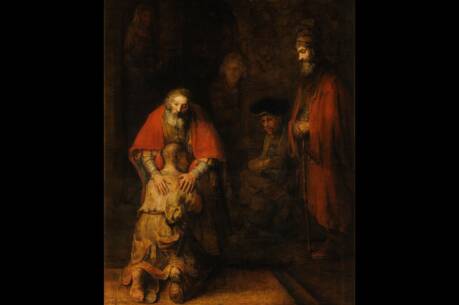Lent reminds us that while sin and death exist, so does hope
As we embark on the 40 days of Lent, today’s readings prompt us to confront our human tendency to sin and our mortality.
Through the obedience of one the many will be made righteous. (Rom 5:19)
What can you do to avoid temptations to sin?
What do you do to seek forgiveness when you sin?
What actions can you take to increase your relationship with God?
The first reading includes two excerpts from the Book of Genesis that describe the creation of the man (later named Adam), the planting of the garden of Eden, in which are found the tree of life and the tree of the knowledge of good and evil, and includes the infamous story of the serpent tempting the woman and man in the garden. The verses omitted from the Lectionary reading describe the creation and naming of animals and the woman (later named Eve). In Genesis 3, the serpent, symbolizing temptation, entices the woman and man to disobey the divine command not to eat the forbidden fruit.
This narrative should be read as an etiology, a story that explains known phenomena. Genesis 3 provides a myth to reveal the causes of human sin and death: disobedience. In this story, the central figures are referred to only as “the woman” and “the man,” allowing them to symbolically represent all people and our propensity to sin. This human attribute is also on display in today’s Gospel reading, which describes Jesus’ temptation to sin.
The Gospel of Matthew depicts Jesus spending 40 days in the desert during a period of fasting, offering us a model for the liturgical season of Lent. In the reading, Matthew suggests that because Jesus was fully human, he too faced temptations to sin. Matthew expands on Mark’s short account of the temptation (Mk 1:12-13) and, like Luke (Lk 4:1-13), includes three explicit refusals to sin. Jesus’ refusals are examples of how we should confront temptations. When we know something is wrong, we should refuse to do it. This may sound overly simplistic, but the Gospel reminds us that the way to begin resisting temptation is to recognize that sin really is sin. Then our course of action is clear: Don’t sin.
Paul’s Letter to the Romans is a great hinge text that connects the first reading and the Gospel. Paul alludes to the Genesis narrative by saying that sin and death entered the world through the actions of one man (Rom 5:12). Yet Paul also highlights the divine gift of grace through Jesus Christ and his ability to overcome sin and death. “Just as through one transgression condemnation came upon all, so, through one righteous act, acquittal and life came to all” (Rom 5:19). Paul asserts a collective identity through the story of disobedience in the garden of Eden. Paul’s logic provides the foundation for what would become the doctrine of original sin. But Paul also asserts a collective redemption through the crucifixion, death and resurrection of Christ.
As we journey through these 40 days of Lent, we can emulate Jesus’ acts of prayer, fasting and almsgiving and recognize his obedience and willingness to sacrifice himself for our salvation. Lent gives us an opportunity to work against temptations towards sinful behavior and instead live simply and justly, inspired by Christ. May these actions guide us through this Lenten season and throughout the year.
This article also appeared in print, under the headline “Confronting Sin and Death,” in the February 17, 2020, issue.









